SEMA7081 Report: Sustainable Energy Management in Three Cities
VerifiedAdded on 2022/11/13
|20
|4814
|201
Report
AI Summary
This report provides a comprehensive analysis of sustainable energy management practices in three major cities: London (UK), Doha (Qatar), and Lagos (Nigeria). It investigates the current systems of sustainable energy implemented in each city, focusing on urban environments (housing), transportation infrastructure, and industrial businesses. The report evaluates the demands of environmental legislation, energy management standards, and ethical practices in the practice of energy management within each city, examining national consumption and production data. Furthermore, it critically assesses the role of health and safety management for sustainable energy generation and energy business management systems. The report also addresses issues related to creating a sustainable management framework and explores the adoption of holistic business perspectives. The findings highlight the varying levels of sustainable development, the impact of industrial practices, and the importance of renewable energy sources in each location, offering insights into the challenges and opportunities for sustainable energy development in these diverse urban settings. The report references various publications and websites to support the findings and recommendations.
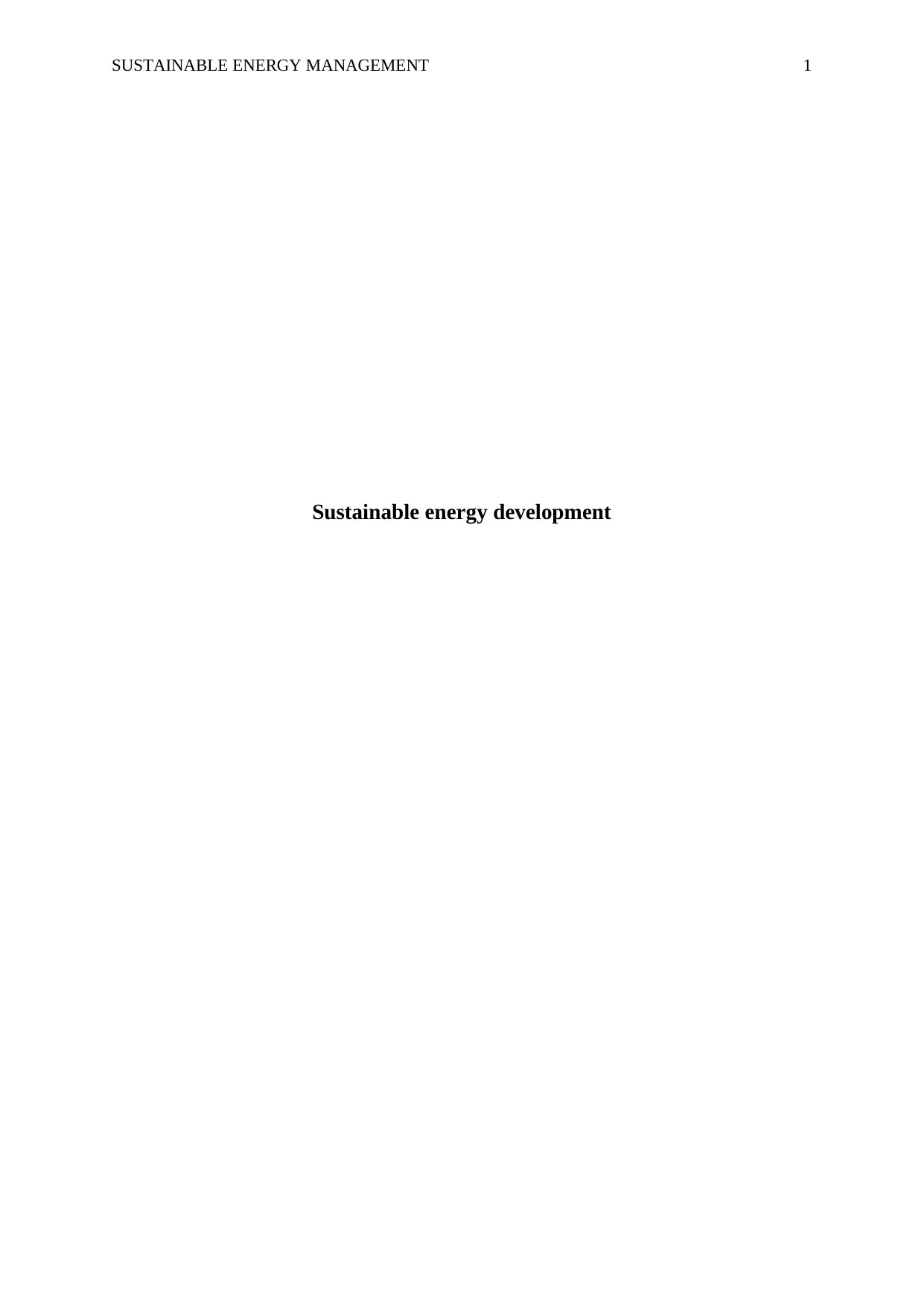
SUSTAINABLE ENERGY MANAGEMENT 1
Sustainable energy development
Sustainable energy development
Paraphrase This Document
Need a fresh take? Get an instant paraphrase of this document with our AI Paraphraser
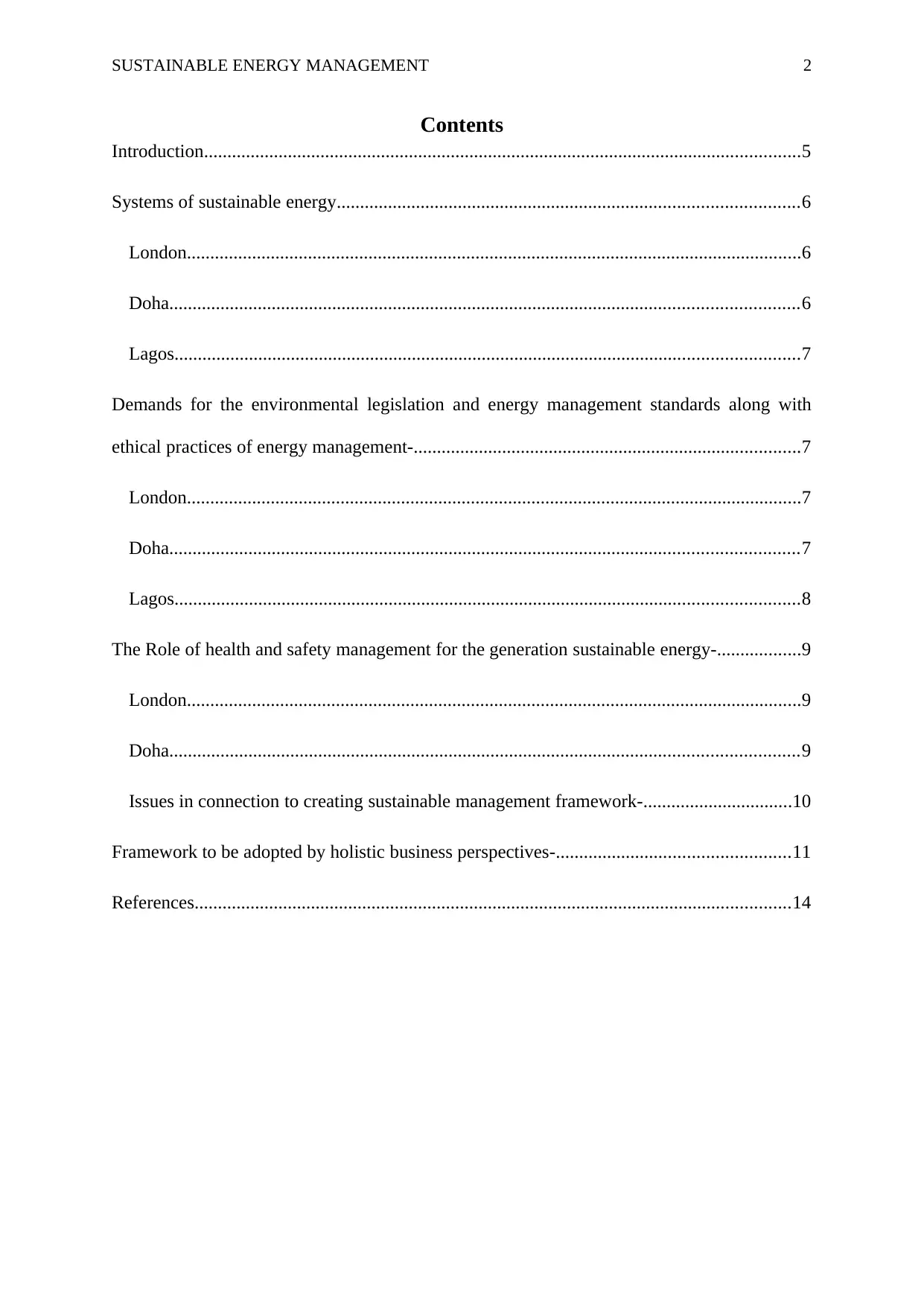
SUSTAINABLE ENERGY MANAGEMENT 2
Contents
Introduction................................................................................................................................5
Systems of sustainable energy...................................................................................................6
London....................................................................................................................................6
Doha.......................................................................................................................................6
Lagos......................................................................................................................................7
Demands for the environmental legislation and energy management standards along with
ethical practices of energy management-...................................................................................7
London....................................................................................................................................7
Doha.......................................................................................................................................7
Lagos......................................................................................................................................8
The Role of health and safety management for the generation sustainable energy-..................9
London....................................................................................................................................9
Doha.......................................................................................................................................9
Issues in connection to creating sustainable management framework-................................10
Framework to be adopted by holistic business perspectives-..................................................11
References................................................................................................................................14
Contents
Introduction................................................................................................................................5
Systems of sustainable energy...................................................................................................6
London....................................................................................................................................6
Doha.......................................................................................................................................6
Lagos......................................................................................................................................7
Demands for the environmental legislation and energy management standards along with
ethical practices of energy management-...................................................................................7
London....................................................................................................................................7
Doha.......................................................................................................................................7
Lagos......................................................................................................................................8
The Role of health and safety management for the generation sustainable energy-..................9
London....................................................................................................................................9
Doha.......................................................................................................................................9
Issues in connection to creating sustainable management framework-................................10
Framework to be adopted by holistic business perspectives-..................................................11
References................................................................................................................................14
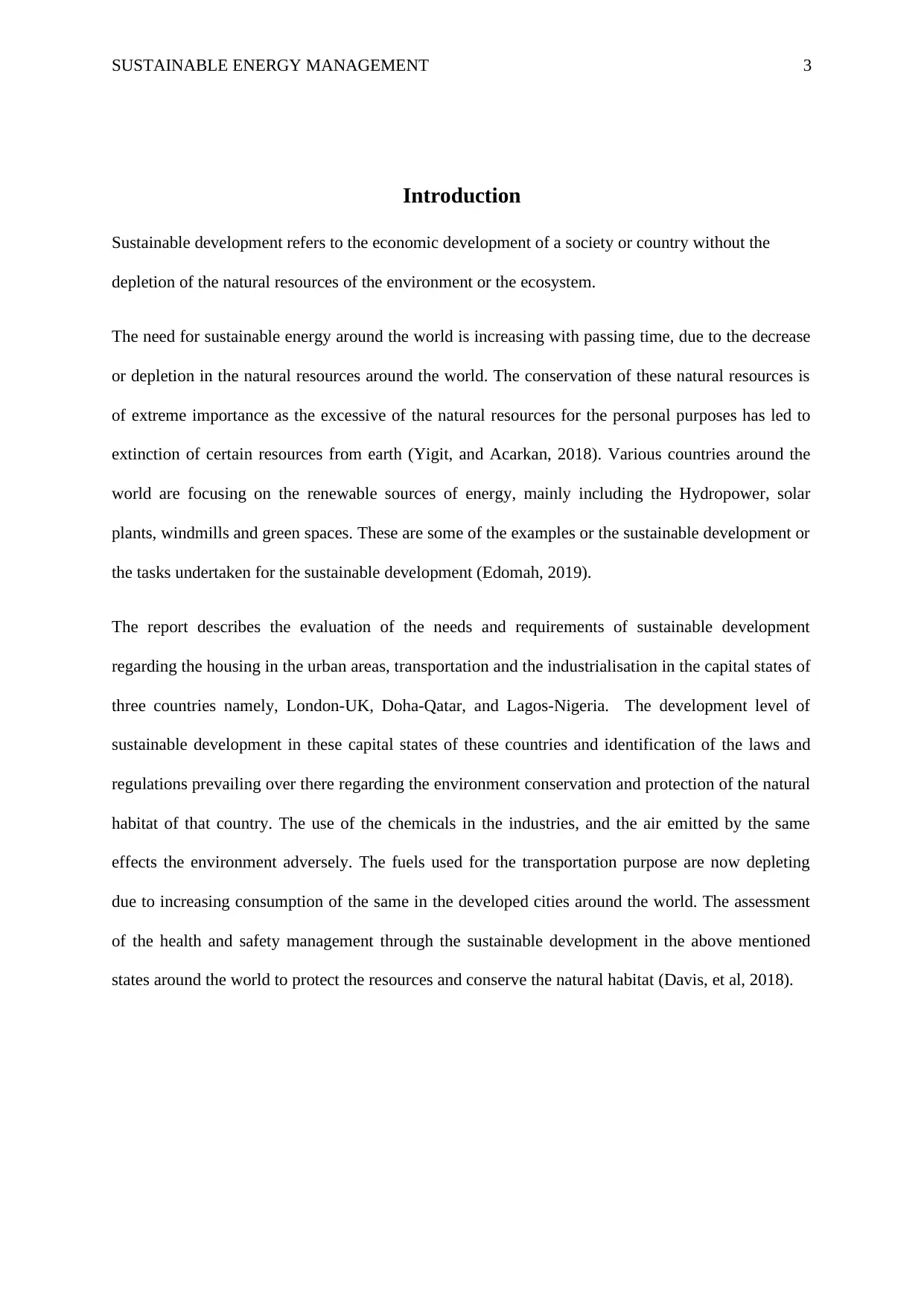
SUSTAINABLE ENERGY MANAGEMENT 3
Introduction
Sustainable development refers to the economic development of a society or country without the
depletion of the natural resources of the environment or the ecosystem.
The need for sustainable energy around the world is increasing with passing time, due to the decrease
or depletion in the natural resources around the world. The conservation of these natural resources is
of extreme importance as the excessive of the natural resources for the personal purposes has led to
extinction of certain resources from earth (Yigit, and Acarkan, 2018). Various countries around the
world are focusing on the renewable sources of energy, mainly including the Hydropower, solar
plants, windmills and green spaces. These are some of the examples or the sustainable development or
the tasks undertaken for the sustainable development (Edomah, 2019).
The report describes the evaluation of the needs and requirements of sustainable development
regarding the housing in the urban areas, transportation and the industrialisation in the capital states of
three countries namely, London-UK, Doha-Qatar, and Lagos-Nigeria. The development level of
sustainable development in these capital states of these countries and identification of the laws and
regulations prevailing over there regarding the environment conservation and protection of the natural
habitat of that country. The use of the chemicals in the industries, and the air emitted by the same
effects the environment adversely. The fuels used for the transportation purpose are now depleting
due to increasing consumption of the same in the developed cities around the world. The assessment
of the health and safety management through the sustainable development in the above mentioned
states around the world to protect the resources and conserve the natural habitat (Davis, et al, 2018).
Introduction
Sustainable development refers to the economic development of a society or country without the
depletion of the natural resources of the environment or the ecosystem.
The need for sustainable energy around the world is increasing with passing time, due to the decrease
or depletion in the natural resources around the world. The conservation of these natural resources is
of extreme importance as the excessive of the natural resources for the personal purposes has led to
extinction of certain resources from earth (Yigit, and Acarkan, 2018). Various countries around the
world are focusing on the renewable sources of energy, mainly including the Hydropower, solar
plants, windmills and green spaces. These are some of the examples or the sustainable development or
the tasks undertaken for the sustainable development (Edomah, 2019).
The report describes the evaluation of the needs and requirements of sustainable development
regarding the housing in the urban areas, transportation and the industrialisation in the capital states of
three countries namely, London-UK, Doha-Qatar, and Lagos-Nigeria. The development level of
sustainable development in these capital states of these countries and identification of the laws and
regulations prevailing over there regarding the environment conservation and protection of the natural
habitat of that country. The use of the chemicals in the industries, and the air emitted by the same
effects the environment adversely. The fuels used for the transportation purpose are now depleting
due to increasing consumption of the same in the developed cities around the world. The assessment
of the health and safety management through the sustainable development in the above mentioned
states around the world to protect the resources and conserve the natural habitat (Davis, et al, 2018).
⊘ This is a preview!⊘
Do you want full access?
Subscribe today to unlock all pages.

Trusted by 1+ million students worldwide
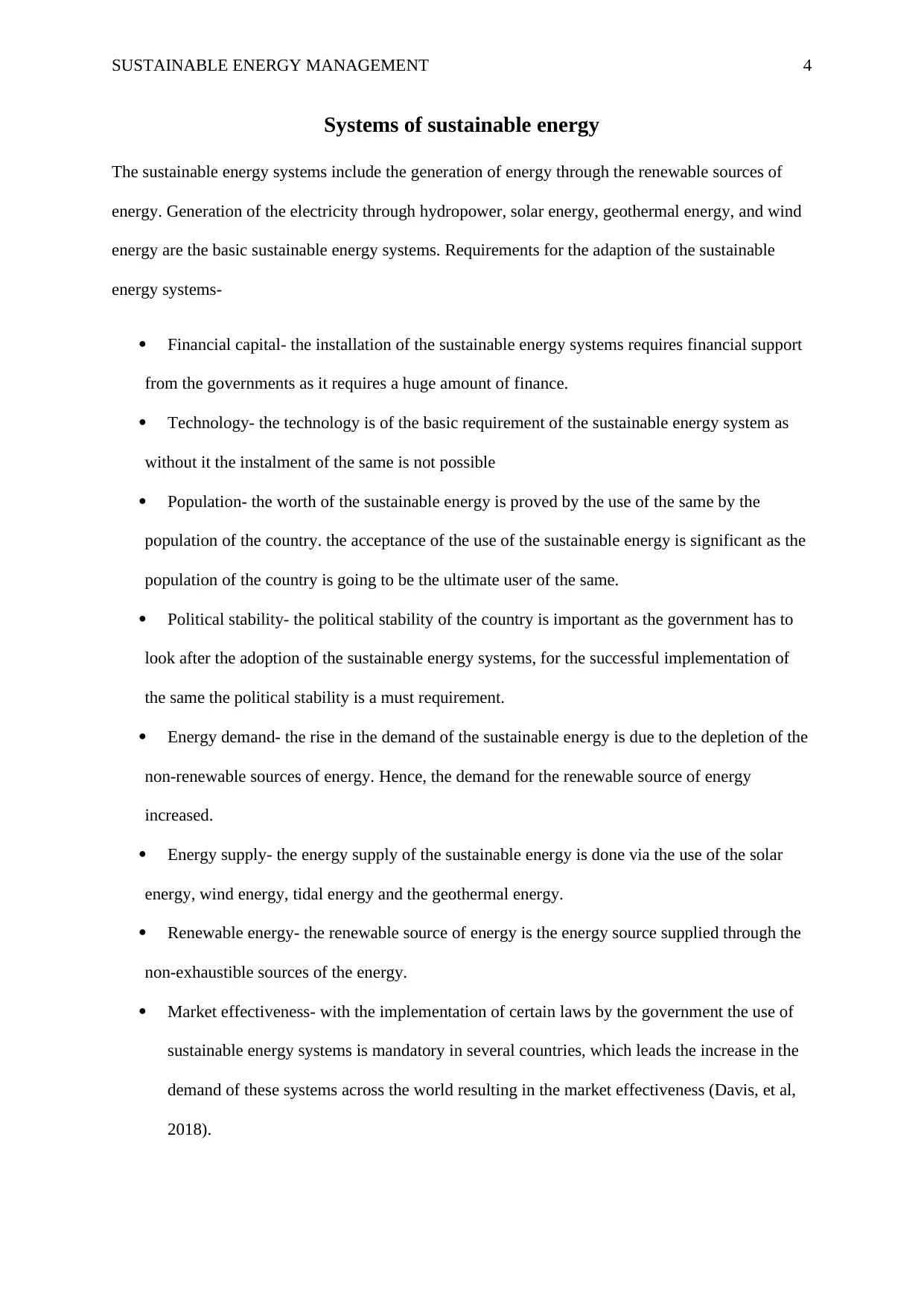
SUSTAINABLE ENERGY MANAGEMENT 4
Systems of sustainable energy
The sustainable energy systems include the generation of energy through the renewable sources of
energy. Generation of the electricity through hydropower, solar energy, geothermal energy, and wind
energy are the basic sustainable energy systems. Requirements for the adaption of the sustainable
energy systems-
Financial capital- the installation of the sustainable energy systems requires financial support
from the governments as it requires a huge amount of finance.
Technology- the technology is of the basic requirement of the sustainable energy system as
without it the instalment of the same is not possible
Population- the worth of the sustainable energy is proved by the use of the same by the
population of the country. the acceptance of the use of the sustainable energy is significant as the
population of the country is going to be the ultimate user of the same.
Political stability- the political stability of the country is important as the government has to
look after the adoption of the sustainable energy systems, for the successful implementation of
the same the political stability is a must requirement.
Energy demand- the rise in the demand of the sustainable energy is due to the depletion of the
non-renewable sources of energy. Hence, the demand for the renewable source of energy
increased.
Energy supply- the energy supply of the sustainable energy is done via the use of the solar
energy, wind energy, tidal energy and the geothermal energy.
Renewable energy- the renewable source of energy is the energy source supplied through the
non-exhaustible sources of the energy.
Market effectiveness- with the implementation of certain laws by the government the use of
sustainable energy systems is mandatory in several countries, which leads the increase in the
demand of these systems across the world resulting in the market effectiveness (Davis, et al,
2018).
Systems of sustainable energy
The sustainable energy systems include the generation of energy through the renewable sources of
energy. Generation of the electricity through hydropower, solar energy, geothermal energy, and wind
energy are the basic sustainable energy systems. Requirements for the adaption of the sustainable
energy systems-
Financial capital- the installation of the sustainable energy systems requires financial support
from the governments as it requires a huge amount of finance.
Technology- the technology is of the basic requirement of the sustainable energy system as
without it the instalment of the same is not possible
Population- the worth of the sustainable energy is proved by the use of the same by the
population of the country. the acceptance of the use of the sustainable energy is significant as the
population of the country is going to be the ultimate user of the same.
Political stability- the political stability of the country is important as the government has to
look after the adoption of the sustainable energy systems, for the successful implementation of
the same the political stability is a must requirement.
Energy demand- the rise in the demand of the sustainable energy is due to the depletion of the
non-renewable sources of energy. Hence, the demand for the renewable source of energy
increased.
Energy supply- the energy supply of the sustainable energy is done via the use of the solar
energy, wind energy, tidal energy and the geothermal energy.
Renewable energy- the renewable source of energy is the energy source supplied through the
non-exhaustible sources of the energy.
Market effectiveness- with the implementation of certain laws by the government the use of
sustainable energy systems is mandatory in several countries, which leads the increase in the
demand of these systems across the world resulting in the market effectiveness (Davis, et al,
2018).
Paraphrase This Document
Need a fresh take? Get an instant paraphrase of this document with our AI Paraphraser
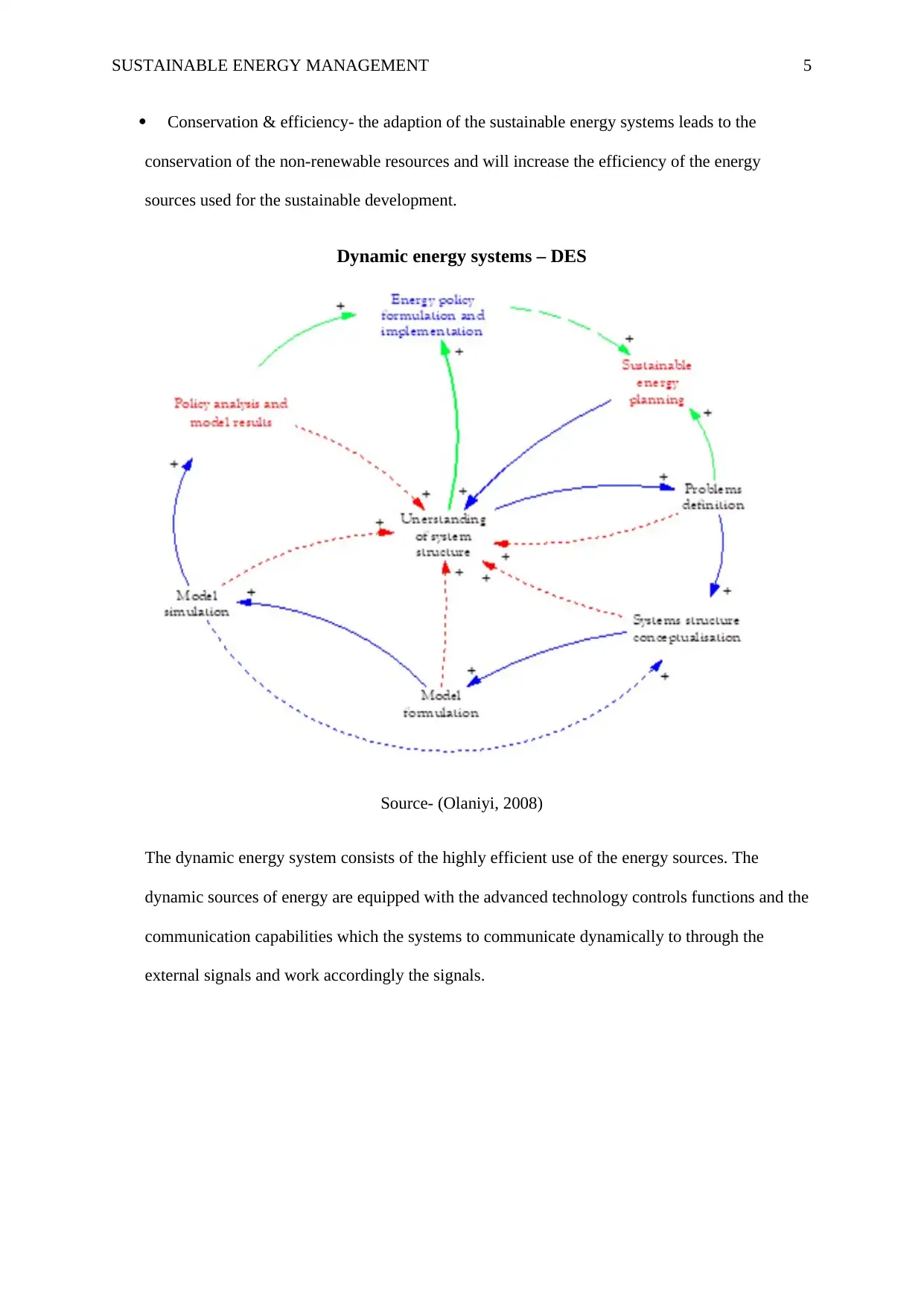
SUSTAINABLE ENERGY MANAGEMENT 5
Conservation & efficiency- the adaption of the sustainable energy systems leads to the
conservation of the non-renewable resources and will increase the efficiency of the energy
sources used for the sustainable development.
Dynamic energy systems – DES
Source- (Olaniyi, 2008)
The dynamic energy system consists of the highly efficient use of the energy sources. The
dynamic sources of energy are equipped with the advanced technology controls functions and the
communication capabilities which the systems to communicate dynamically to through the
external signals and work accordingly the signals.
Conservation & efficiency- the adaption of the sustainable energy systems leads to the
conservation of the non-renewable resources and will increase the efficiency of the energy
sources used for the sustainable development.
Dynamic energy systems – DES
Source- (Olaniyi, 2008)
The dynamic energy system consists of the highly efficient use of the energy sources. The
dynamic sources of energy are equipped with the advanced technology controls functions and the
communication capabilities which the systems to communicate dynamically to through the
external signals and work accordingly the signals.
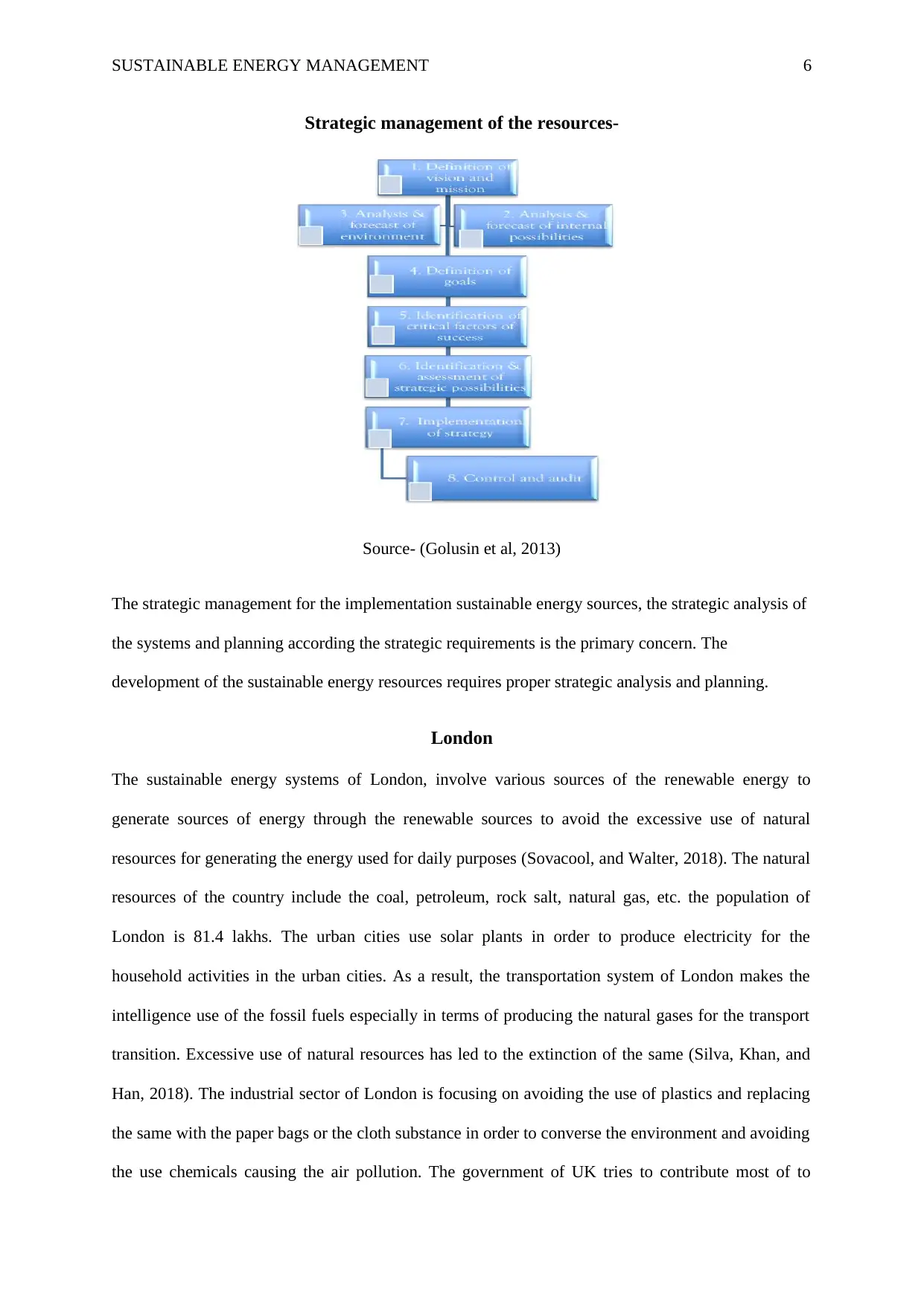
SUSTAINABLE ENERGY MANAGEMENT 6
Strategic management of the resources-
Source- (Golusin et al, 2013)
The strategic management for the implementation sustainable energy sources, the strategic analysis of
the systems and planning according the strategic requirements is the primary concern. The
development of the sustainable energy resources requires proper strategic analysis and planning.
London
The sustainable energy systems of London, involve various sources of the renewable energy to
generate sources of energy through the renewable sources to avoid the excessive use of natural
resources for generating the energy used for daily purposes (Sovacool, and Walter, 2018). The natural
resources of the country include the coal, petroleum, rock salt, natural gas, etc. the population of
London is 81.4 lakhs. The urban cities use solar plants in order to produce electricity for the
household activities in the urban cities. As a result, the transportation system of London makes the
intelligence use of the fossil fuels especially in terms of producing the natural gases for the transport
transition. Excessive use of natural resources has led to the extinction of the same (Silva, Khan, and
Han, 2018). The industrial sector of London is focusing on avoiding the use of plastics and replacing
the same with the paper bags or the cloth substance in order to converse the environment and avoiding
the use chemicals causing the air pollution. The government of UK tries to contribute most of to
Strategic management of the resources-
Source- (Golusin et al, 2013)
The strategic management for the implementation sustainable energy sources, the strategic analysis of
the systems and planning according the strategic requirements is the primary concern. The
development of the sustainable energy resources requires proper strategic analysis and planning.
London
The sustainable energy systems of London, involve various sources of the renewable energy to
generate sources of energy through the renewable sources to avoid the excessive use of natural
resources for generating the energy used for daily purposes (Sovacool, and Walter, 2018). The natural
resources of the country include the coal, petroleum, rock salt, natural gas, etc. the population of
London is 81.4 lakhs. The urban cities use solar plants in order to produce electricity for the
household activities in the urban cities. As a result, the transportation system of London makes the
intelligence use of the fossil fuels especially in terms of producing the natural gases for the transport
transition. Excessive use of natural resources has led to the extinction of the same (Silva, Khan, and
Han, 2018). The industrial sector of London is focusing on avoiding the use of plastics and replacing
the same with the paper bags or the cloth substance in order to converse the environment and avoiding
the use chemicals causing the air pollution. The government of UK tries to contribute most of to
⊘ This is a preview!⊘
Do you want full access?
Subscribe today to unlock all pages.

Trusted by 1+ million students worldwide
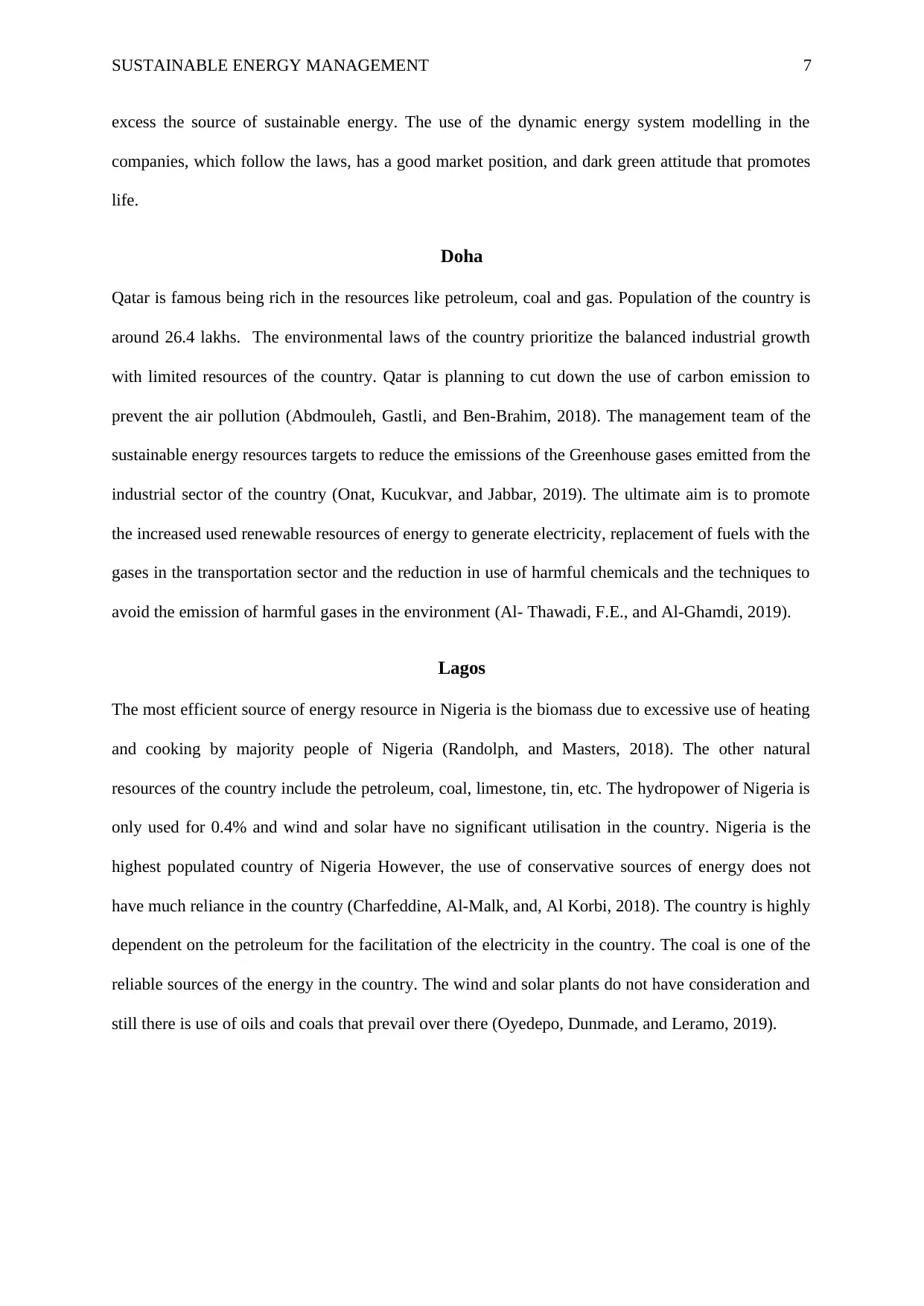
SUSTAINABLE ENERGY MANAGEMENT 7
excess the source of sustainable energy. The use of the dynamic energy system modelling in the
companies, which follow the laws, has a good market position, and dark green attitude that promotes
life.
Doha
Qatar is famous being rich in the resources like petroleum, coal and gas. Population of the country is
around 26.4 lakhs. The environmental laws of the country prioritize the balanced industrial growth
with limited resources of the country. Qatar is planning to cut down the use of carbon emission to
prevent the air pollution (Abdmouleh, Gastli, and Ben-Brahim, 2018). The management team of the
sustainable energy resources targets to reduce the emissions of the Greenhouse gases emitted from the
industrial sector of the country (Onat, Kucukvar, and Jabbar, 2019). The ultimate aim is to promote
the increased used renewable resources of energy to generate electricity, replacement of fuels with the
gases in the transportation sector and the reduction in use of harmful chemicals and the techniques to
avoid the emission of harmful gases in the environment (Al- Thawadi, F.E., and Al-Ghamdi, 2019).
Lagos
The most efficient source of energy resource in Nigeria is the biomass due to excessive use of heating
and cooking by majority people of Nigeria (Randolph, and Masters, 2018). The other natural
resources of the country include the petroleum, coal, limestone, tin, etc. The hydropower of Nigeria is
only used for 0.4% and wind and solar have no significant utilisation in the country. Nigeria is the
highest populated country of Nigeria However, the use of conservative sources of energy does not
have much reliance in the country (Charfeddine, Al-Malk, and, Al Korbi, 2018). The country is highly
dependent on the petroleum for the facilitation of the electricity in the country. The coal is one of the
reliable sources of the energy in the country. The wind and solar plants do not have consideration and
still there is use of oils and coals that prevail over there (Oyedepo, Dunmade, and Leramo, 2019).
excess the source of sustainable energy. The use of the dynamic energy system modelling in the
companies, which follow the laws, has a good market position, and dark green attitude that promotes
life.
Doha
Qatar is famous being rich in the resources like petroleum, coal and gas. Population of the country is
around 26.4 lakhs. The environmental laws of the country prioritize the balanced industrial growth
with limited resources of the country. Qatar is planning to cut down the use of carbon emission to
prevent the air pollution (Abdmouleh, Gastli, and Ben-Brahim, 2018). The management team of the
sustainable energy resources targets to reduce the emissions of the Greenhouse gases emitted from the
industrial sector of the country (Onat, Kucukvar, and Jabbar, 2019). The ultimate aim is to promote
the increased used renewable resources of energy to generate electricity, replacement of fuels with the
gases in the transportation sector and the reduction in use of harmful chemicals and the techniques to
avoid the emission of harmful gases in the environment (Al- Thawadi, F.E., and Al-Ghamdi, 2019).
Lagos
The most efficient source of energy resource in Nigeria is the biomass due to excessive use of heating
and cooking by majority people of Nigeria (Randolph, and Masters, 2018). The other natural
resources of the country include the petroleum, coal, limestone, tin, etc. The hydropower of Nigeria is
only used for 0.4% and wind and solar have no significant utilisation in the country. Nigeria is the
highest populated country of Nigeria However, the use of conservative sources of energy does not
have much reliance in the country (Charfeddine, Al-Malk, and, Al Korbi, 2018). The country is highly
dependent on the petroleum for the facilitation of the electricity in the country. The coal is one of the
reliable sources of the energy in the country. The wind and solar plants do not have consideration and
still there is use of oils and coals that prevail over there (Oyedepo, Dunmade, and Leramo, 2019).
Paraphrase This Document
Need a fresh take? Get an instant paraphrase of this document with our AI Paraphraser
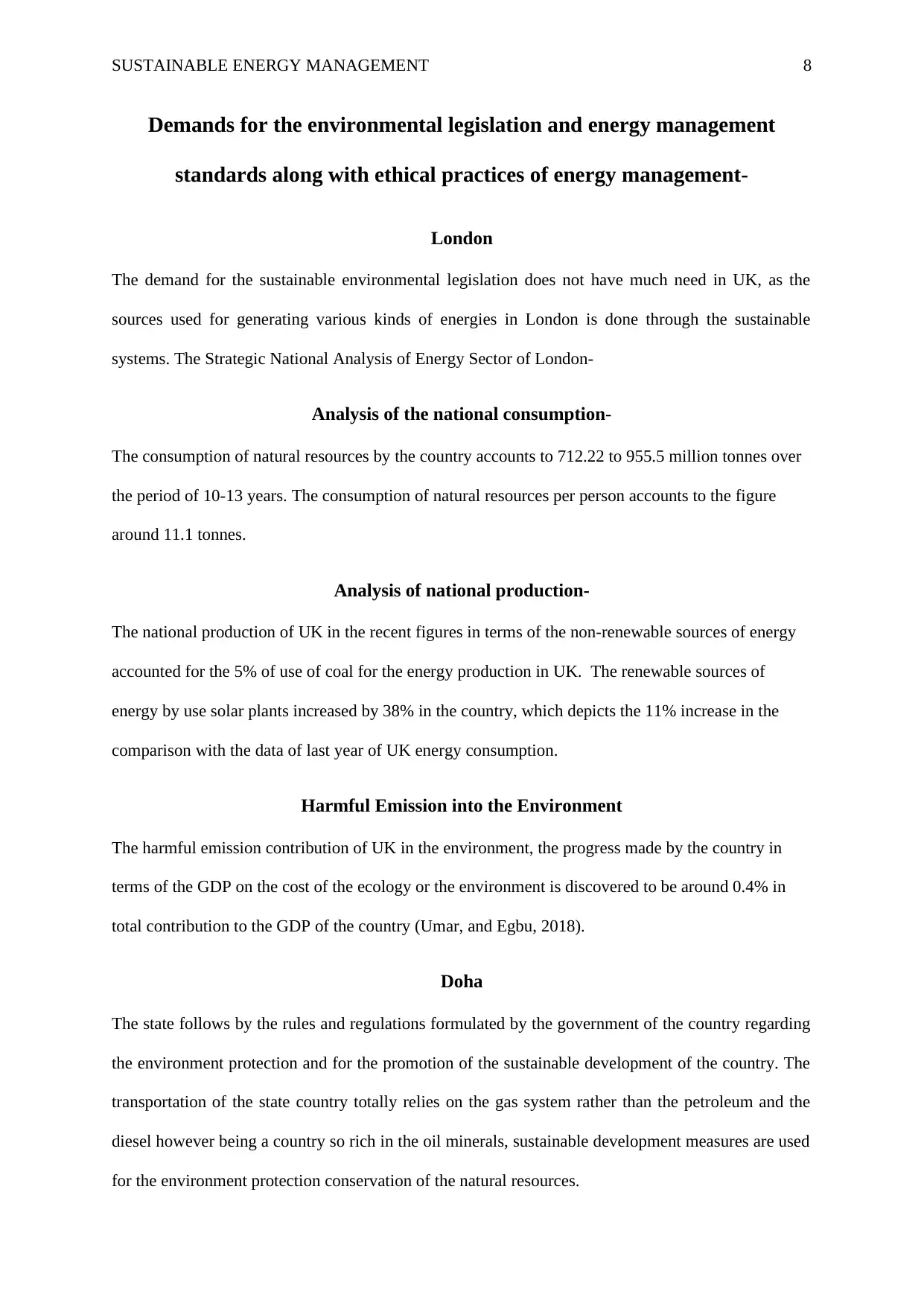
SUSTAINABLE ENERGY MANAGEMENT 8
Demands for the environmental legislation and energy management
standards along with ethical practices of energy management-
London
The demand for the sustainable environmental legislation does not have much need in UK, as the
sources used for generating various kinds of energies in London is done through the sustainable
systems. The Strategic National Analysis of Energy Sector of London-
Analysis of the national consumption-
The consumption of natural resources by the country accounts to 712.22 to 955.5 million tonnes over
the period of 10-13 years. The consumption of natural resources per person accounts to the figure
around 11.1 tonnes.
Analysis of national production-
The national production of UK in the recent figures in terms of the non-renewable sources of energy
accounted for the 5% of use of coal for the energy production in UK. The renewable sources of
energy by use solar plants increased by 38% in the country, which depicts the 11% increase in the
comparison with the data of last year of UK energy consumption.
Harmful Emission into the Environment
The harmful emission contribution of UK in the environment, the progress made by the country in
terms of the GDP on the cost of the ecology or the environment is discovered to be around 0.4% in
total contribution to the GDP of the country (Umar, and Egbu, 2018).
Doha
The state follows by the rules and regulations formulated by the government of the country regarding
the environment protection and for the promotion of the sustainable development of the country. The
transportation of the state country totally relies on the gas system rather than the petroleum and the
diesel however being a country so rich in the oil minerals, sustainable development measures are used
for the environment protection conservation of the natural resources.
Demands for the environmental legislation and energy management
standards along with ethical practices of energy management-
London
The demand for the sustainable environmental legislation does not have much need in UK, as the
sources used for generating various kinds of energies in London is done through the sustainable
systems. The Strategic National Analysis of Energy Sector of London-
Analysis of the national consumption-
The consumption of natural resources by the country accounts to 712.22 to 955.5 million tonnes over
the period of 10-13 years. The consumption of natural resources per person accounts to the figure
around 11.1 tonnes.
Analysis of national production-
The national production of UK in the recent figures in terms of the non-renewable sources of energy
accounted for the 5% of use of coal for the energy production in UK. The renewable sources of
energy by use solar plants increased by 38% in the country, which depicts the 11% increase in the
comparison with the data of last year of UK energy consumption.
Harmful Emission into the Environment
The harmful emission contribution of UK in the environment, the progress made by the country in
terms of the GDP on the cost of the ecology or the environment is discovered to be around 0.4% in
total contribution to the GDP of the country (Umar, and Egbu, 2018).
Doha
The state follows by the rules and regulations formulated by the government of the country regarding
the environment protection and for the promotion of the sustainable development of the country. The
transportation of the state country totally relies on the gas system rather than the petroleum and the
diesel however being a country so rich in the oil minerals, sustainable development measures are used
for the environment protection conservation of the natural resources.
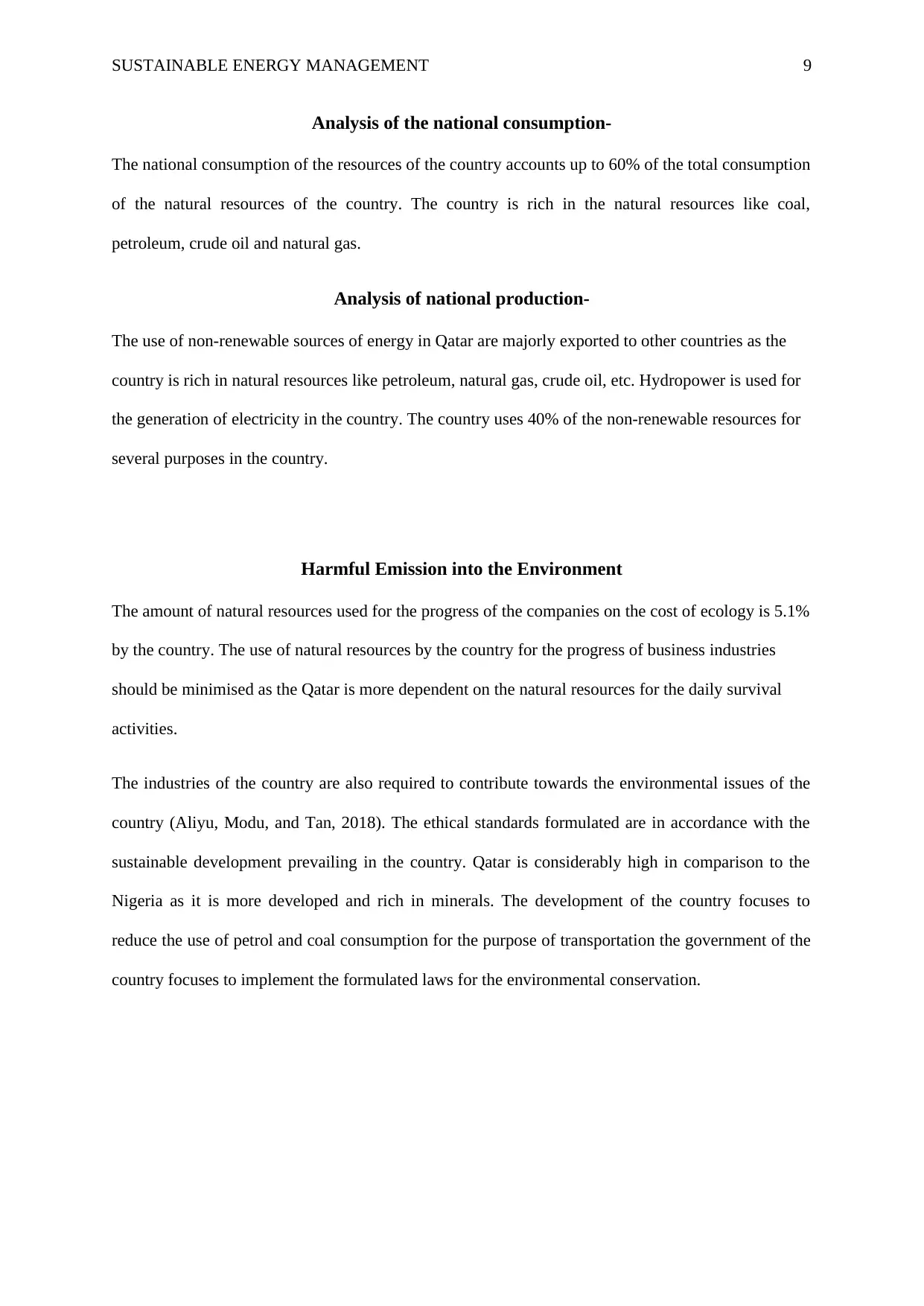
SUSTAINABLE ENERGY MANAGEMENT 9
Analysis of the national consumption-
The national consumption of the resources of the country accounts up to 60% of the total consumption
of the natural resources of the country. The country is rich in the natural resources like coal,
petroleum, crude oil and natural gas.
Analysis of national production-
The use of non-renewable sources of energy in Qatar are majorly exported to other countries as the
country is rich in natural resources like petroleum, natural gas, crude oil, etc. Hydropower is used for
the generation of electricity in the country. The country uses 40% of the non-renewable resources for
several purposes in the country.
Harmful Emission into the Environment
The amount of natural resources used for the progress of the companies on the cost of ecology is 5.1%
by the country. The use of natural resources by the country for the progress of business industries
should be minimised as the Qatar is more dependent on the natural resources for the daily survival
activities.
The industries of the country are also required to contribute towards the environmental issues of the
country (Aliyu, Modu, and Tan, 2018). The ethical standards formulated are in accordance with the
sustainable development prevailing in the country. Qatar is considerably high in comparison to the
Nigeria as it is more developed and rich in minerals. The development of the country focuses to
reduce the use of petrol and coal consumption for the purpose of transportation the government of the
country focuses to implement the formulated laws for the environmental conservation.
Analysis of the national consumption-
The national consumption of the resources of the country accounts up to 60% of the total consumption
of the natural resources of the country. The country is rich in the natural resources like coal,
petroleum, crude oil and natural gas.
Analysis of national production-
The use of non-renewable sources of energy in Qatar are majorly exported to other countries as the
country is rich in natural resources like petroleum, natural gas, crude oil, etc. Hydropower is used for
the generation of electricity in the country. The country uses 40% of the non-renewable resources for
several purposes in the country.
Harmful Emission into the Environment
The amount of natural resources used for the progress of the companies on the cost of ecology is 5.1%
by the country. The use of natural resources by the country for the progress of business industries
should be minimised as the Qatar is more dependent on the natural resources for the daily survival
activities.
The industries of the country are also required to contribute towards the environmental issues of the
country (Aliyu, Modu, and Tan, 2018). The ethical standards formulated are in accordance with the
sustainable development prevailing in the country. Qatar is considerably high in comparison to the
Nigeria as it is more developed and rich in minerals. The development of the country focuses to
reduce the use of petrol and coal consumption for the purpose of transportation the government of the
country focuses to implement the formulated laws for the environmental conservation.
⊘ This is a preview!⊘
Do you want full access?
Subscribe today to unlock all pages.

Trusted by 1+ million students worldwide
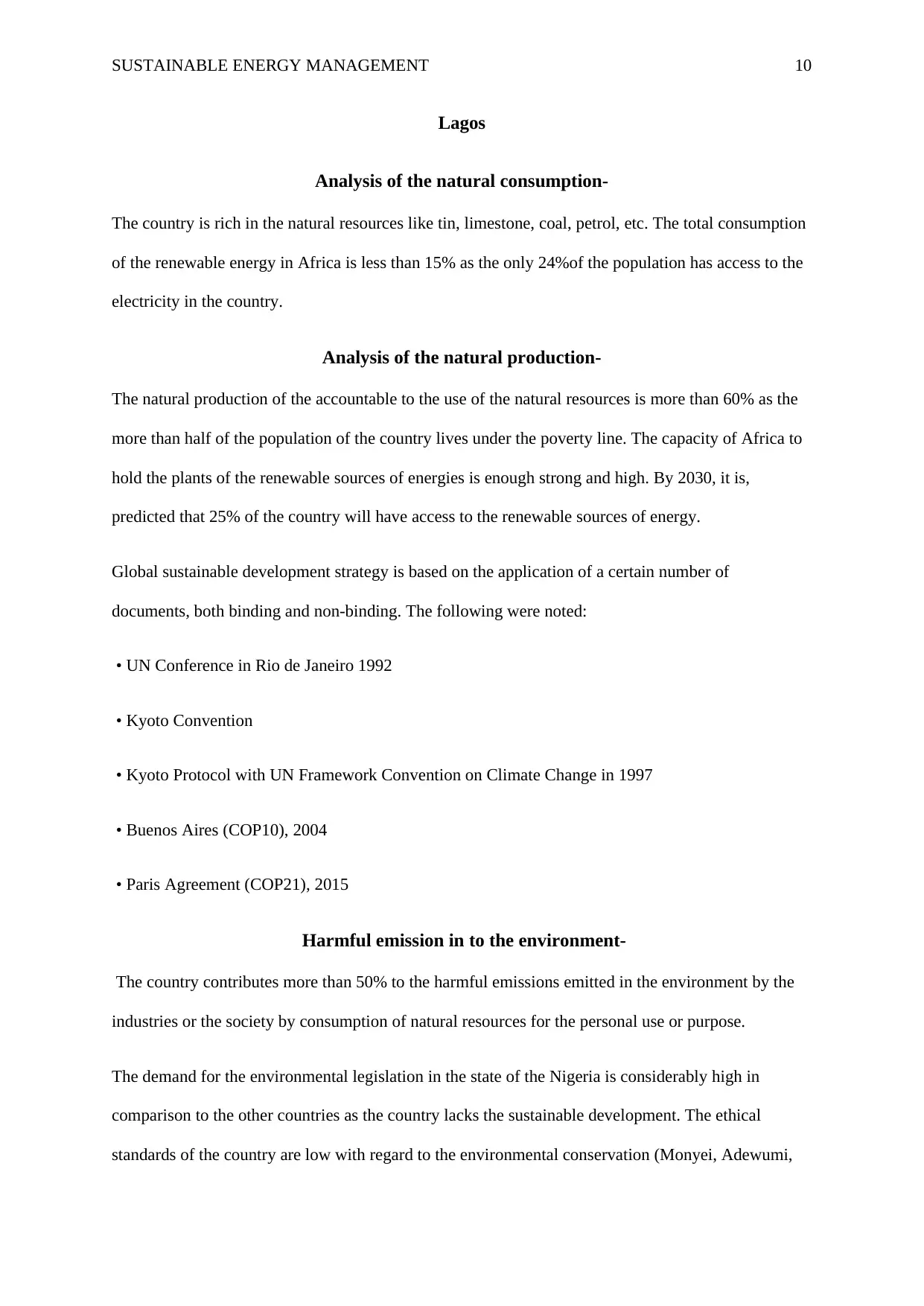
SUSTAINABLE ENERGY MANAGEMENT 10
Lagos
Analysis of the natural consumption-
The country is rich in the natural resources like tin, limestone, coal, petrol, etc. The total consumption
of the renewable energy in Africa is less than 15% as the only 24%of the population has access to the
electricity in the country.
Analysis of the natural production-
The natural production of the accountable to the use of the natural resources is more than 60% as the
more than half of the population of the country lives under the poverty line. The capacity of Africa to
hold the plants of the renewable sources of energies is enough strong and high. By 2030, it is,
predicted that 25% of the country will have access to the renewable sources of energy.
Global sustainable development strategy is based on the application of a certain number of
documents, both binding and non-binding. The following were noted:
• UN Conference in Rio de Janeiro 1992
• Kyoto Convention
• Kyoto Protocol with UN Framework Convention on Climate Change in 1997
• Buenos Aires (COP10), 2004
• Paris Agreement (COP21), 2015
Harmful emission in to the environment-
The country contributes more than 50% to the harmful emissions emitted in the environment by the
industries or the society by consumption of natural resources for the personal use or purpose.
The demand for the environmental legislation in the state of the Nigeria is considerably high in
comparison to the other countries as the country lacks the sustainable development. The ethical
standards of the country are low with regard to the environmental conservation (Monyei, Adewumi,
Lagos
Analysis of the natural consumption-
The country is rich in the natural resources like tin, limestone, coal, petrol, etc. The total consumption
of the renewable energy in Africa is less than 15% as the only 24%of the population has access to the
electricity in the country.
Analysis of the natural production-
The natural production of the accountable to the use of the natural resources is more than 60% as the
more than half of the population of the country lives under the poverty line. The capacity of Africa to
hold the plants of the renewable sources of energies is enough strong and high. By 2030, it is,
predicted that 25% of the country will have access to the renewable sources of energy.
Global sustainable development strategy is based on the application of a certain number of
documents, both binding and non-binding. The following were noted:
• UN Conference in Rio de Janeiro 1992
• Kyoto Convention
• Kyoto Protocol with UN Framework Convention on Climate Change in 1997
• Buenos Aires (COP10), 2004
• Paris Agreement (COP21), 2015
Harmful emission in to the environment-
The country contributes more than 50% to the harmful emissions emitted in the environment by the
industries or the society by consumption of natural resources for the personal use or purpose.
The demand for the environmental legislation in the state of the Nigeria is considerably high in
comparison to the other countries as the country lacks the sustainable development. The ethical
standards of the country are low with regard to the environmental conservation (Monyei, Adewumi,
Paraphrase This Document
Need a fresh take? Get an instant paraphrase of this document with our AI Paraphraser
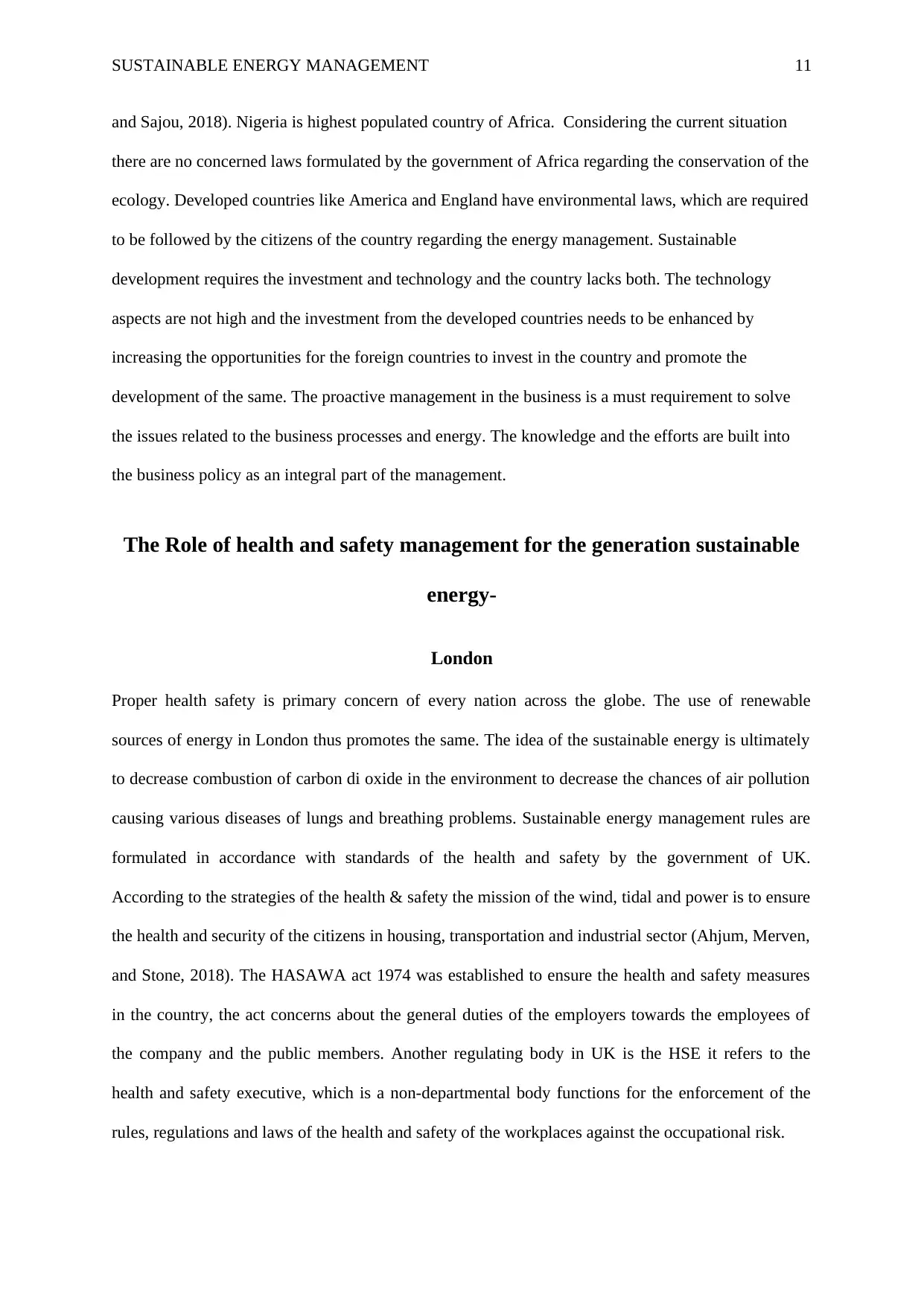
SUSTAINABLE ENERGY MANAGEMENT 11
and Sajou, 2018). Nigeria is highest populated country of Africa. Considering the current situation
there are no concerned laws formulated by the government of Africa regarding the conservation of the
ecology. Developed countries like America and England have environmental laws, which are required
to be followed by the citizens of the country regarding the energy management. Sustainable
development requires the investment and technology and the country lacks both. The technology
aspects are not high and the investment from the developed countries needs to be enhanced by
increasing the opportunities for the foreign countries to invest in the country and promote the
development of the same. The proactive management in the business is a must requirement to solve
the issues related to the business processes and energy. The knowledge and the efforts are built into
the business policy as an integral part of the management.
The Role of health and safety management for the generation sustainable
energy-
London
Proper health safety is primary concern of every nation across the globe. The use of renewable
sources of energy in London thus promotes the same. The idea of the sustainable energy is ultimately
to decrease combustion of carbon di oxide in the environment to decrease the chances of air pollution
causing various diseases of lungs and breathing problems. Sustainable energy management rules are
formulated in accordance with standards of the health and safety by the government of UK.
According to the strategies of the health & safety the mission of the wind, tidal and power is to ensure
the health and security of the citizens in housing, transportation and industrial sector (Ahjum, Merven,
and Stone, 2018). The HASAWA act 1974 was established to ensure the health and safety measures
in the country, the act concerns about the general duties of the employers towards the employees of
the company and the public members. Another regulating body in UK is the HSE it refers to the
health and safety executive, which is a non-departmental body functions for the enforcement of the
rules, regulations and laws of the health and safety of the workplaces against the occupational risk.
and Sajou, 2018). Nigeria is highest populated country of Africa. Considering the current situation
there are no concerned laws formulated by the government of Africa regarding the conservation of the
ecology. Developed countries like America and England have environmental laws, which are required
to be followed by the citizens of the country regarding the energy management. Sustainable
development requires the investment and technology and the country lacks both. The technology
aspects are not high and the investment from the developed countries needs to be enhanced by
increasing the opportunities for the foreign countries to invest in the country and promote the
development of the same. The proactive management in the business is a must requirement to solve
the issues related to the business processes and energy. The knowledge and the efforts are built into
the business policy as an integral part of the management.
The Role of health and safety management for the generation sustainable
energy-
London
Proper health safety is primary concern of every nation across the globe. The use of renewable
sources of energy in London thus promotes the same. The idea of the sustainable energy is ultimately
to decrease combustion of carbon di oxide in the environment to decrease the chances of air pollution
causing various diseases of lungs and breathing problems. Sustainable energy management rules are
formulated in accordance with standards of the health and safety by the government of UK.
According to the strategies of the health & safety the mission of the wind, tidal and power is to ensure
the health and security of the citizens in housing, transportation and industrial sector (Ahjum, Merven,
and Stone, 2018). The HASAWA act 1974 was established to ensure the health and safety measures
in the country, the act concerns about the general duties of the employers towards the employees of
the company and the public members. Another regulating body in UK is the HSE it refers to the
health and safety executive, which is a non-departmental body functions for the enforcement of the
rules, regulations and laws of the health and safety of the workplaces against the occupational risk.
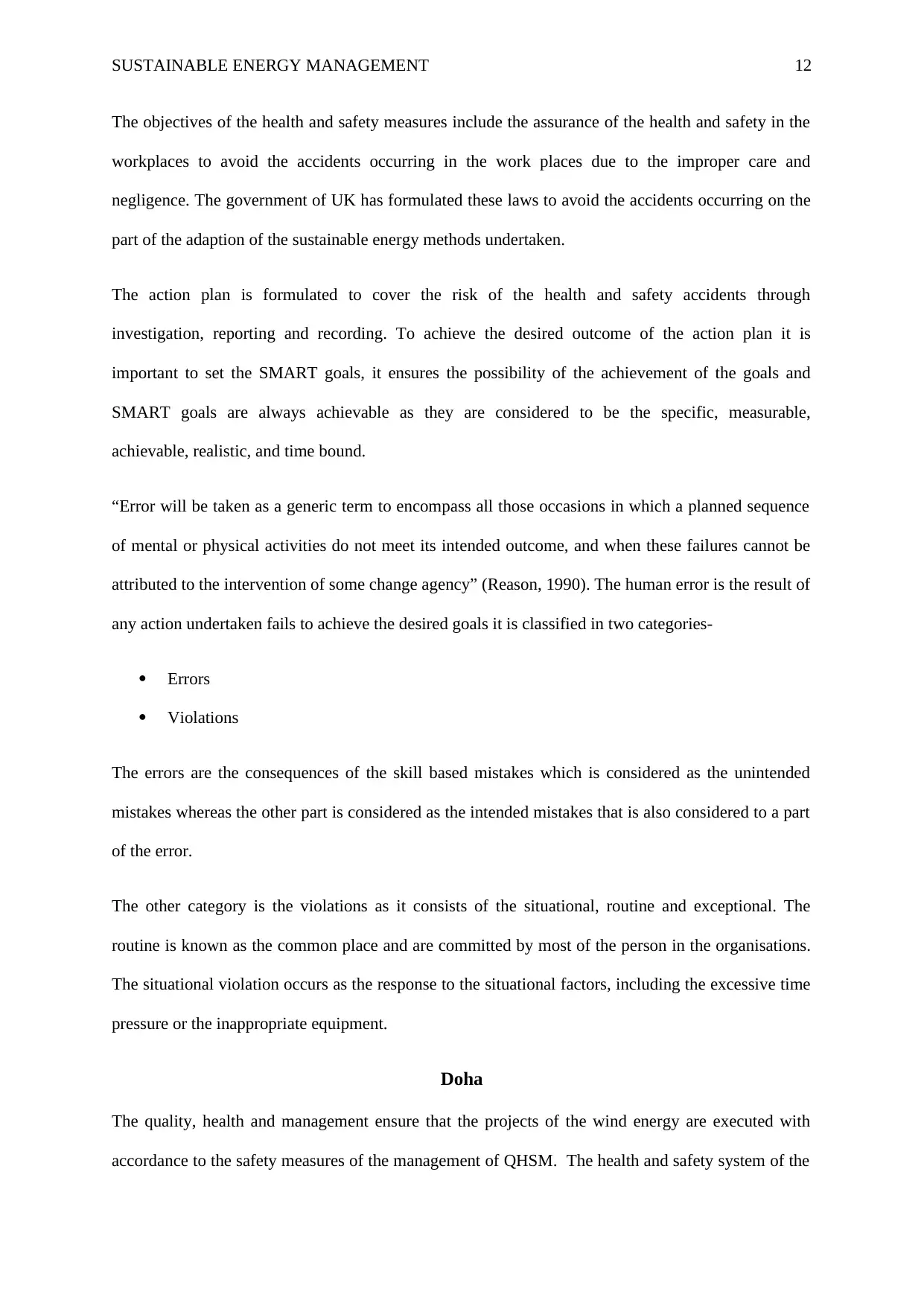
SUSTAINABLE ENERGY MANAGEMENT 12
The objectives of the health and safety measures include the assurance of the health and safety in the
workplaces to avoid the accidents occurring in the work places due to the improper care and
negligence. The government of UK has formulated these laws to avoid the accidents occurring on the
part of the adaption of the sustainable energy methods undertaken.
The action plan is formulated to cover the risk of the health and safety accidents through
investigation, reporting and recording. To achieve the desired outcome of the action plan it is
important to set the SMART goals, it ensures the possibility of the achievement of the goals and
SMART goals are always achievable as they are considered to be the specific, measurable,
achievable, realistic, and time bound.
“Error will be taken as a generic term to encompass all those occasions in which a planned sequence
of mental or physical activities do not meet its intended outcome, and when these failures cannot be
attributed to the intervention of some change agency” (Reason, 1990). The human error is the result of
any action undertaken fails to achieve the desired goals it is classified in two categories-
Errors
Violations
The errors are the consequences of the skill based mistakes which is considered as the unintended
mistakes whereas the other part is considered as the intended mistakes that is also considered to a part
of the error.
The other category is the violations as it consists of the situational, routine and exceptional. The
routine is known as the common place and are committed by most of the person in the organisations.
The situational violation occurs as the response to the situational factors, including the excessive time
pressure or the inappropriate equipment.
Doha
The quality, health and management ensure that the projects of the wind energy are executed with
accordance to the safety measures of the management of QHSM. The health and safety system of the
The objectives of the health and safety measures include the assurance of the health and safety in the
workplaces to avoid the accidents occurring in the work places due to the improper care and
negligence. The government of UK has formulated these laws to avoid the accidents occurring on the
part of the adaption of the sustainable energy methods undertaken.
The action plan is formulated to cover the risk of the health and safety accidents through
investigation, reporting and recording. To achieve the desired outcome of the action plan it is
important to set the SMART goals, it ensures the possibility of the achievement of the goals and
SMART goals are always achievable as they are considered to be the specific, measurable,
achievable, realistic, and time bound.
“Error will be taken as a generic term to encompass all those occasions in which a planned sequence
of mental or physical activities do not meet its intended outcome, and when these failures cannot be
attributed to the intervention of some change agency” (Reason, 1990). The human error is the result of
any action undertaken fails to achieve the desired goals it is classified in two categories-
Errors
Violations
The errors are the consequences of the skill based mistakes which is considered as the unintended
mistakes whereas the other part is considered as the intended mistakes that is also considered to a part
of the error.
The other category is the violations as it consists of the situational, routine and exceptional. The
routine is known as the common place and are committed by most of the person in the organisations.
The situational violation occurs as the response to the situational factors, including the excessive time
pressure or the inappropriate equipment.
Doha
The quality, health and management ensure that the projects of the wind energy are executed with
accordance to the safety measures of the management of QHSM. The health and safety system of the
⊘ This is a preview!⊘
Do you want full access?
Subscribe today to unlock all pages.

Trusted by 1+ million students worldwide
1 out of 20
Related Documents
Your All-in-One AI-Powered Toolkit for Academic Success.
+13062052269
info@desklib.com
Available 24*7 on WhatsApp / Email
![[object Object]](/_next/static/media/star-bottom.7253800d.svg)
Unlock your academic potential
Copyright © 2020–2025 A2Z Services. All Rights Reserved. Developed and managed by ZUCOL.




